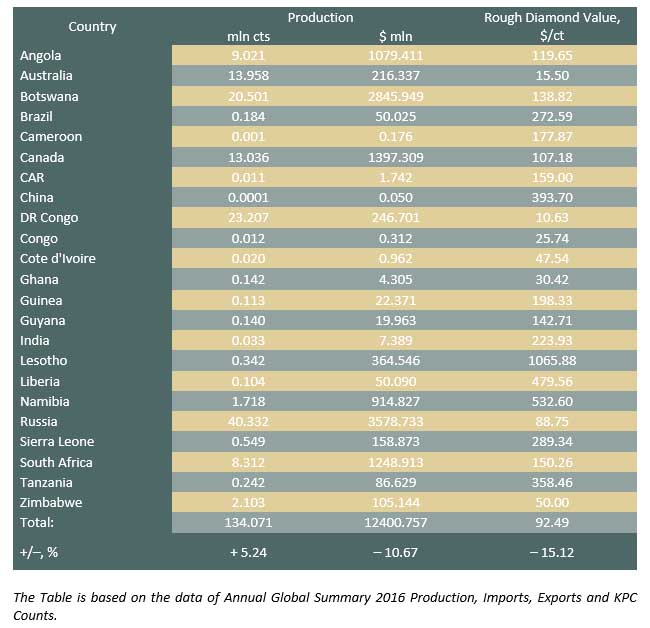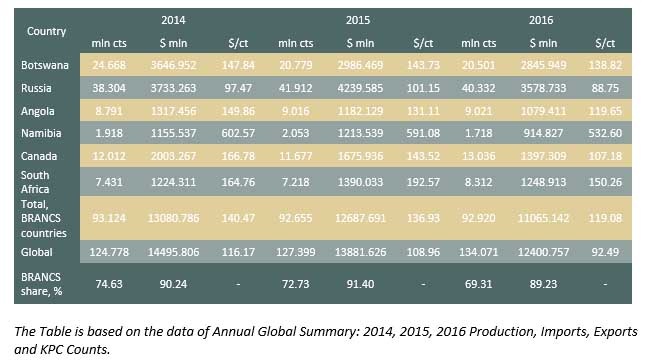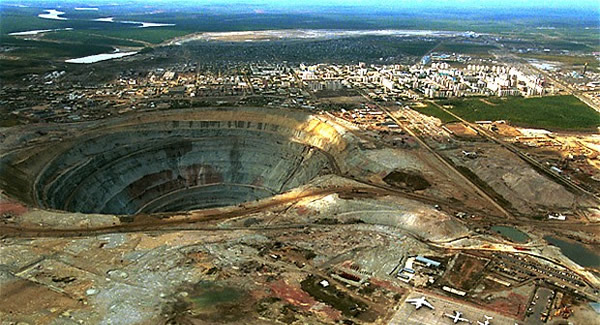The Kimberley process with its 54 member-countries made the statistics on of the rough diamond production and trade open and available for studies by all the countries in the world. A small number of countries involved in the diamond business makes it easier. In 2016, the rough diamonds were produced by 23 countries in the world.
Rough diamond production in 2016 (split by country)

Data analysis shows that the value of the diamonds mined in the world decreased by 10.67% in spite of the 5.24 per cent growth in the diamond production and due to the rough diamond price drop by 15.12%. The average price of rough diamonds was $92.49 per carat.
The most expensive diamonds are produced in Lesotho – $1,065.88/ct, and Namibia, Liberia, Sierra Leone and Tanzania, which is explained by alluvial diamond mining and primitive mining technology (except for Namibia), when mainly large stones are recovered only.
Among the countries mining the diamonds from solid rocks, the price for rough diamonds is much higher than the world average one in the South Africa being $150.26/ct, as well as in Canada, Botswana (De Beers operations mine there) and Angola. The value of diamonds produced in Russia is a little lower due to different technologies used in the diamond beneficiation. At the beneficiation plants in Russia, autogenous grinding mills – recovering 5 mm – 0.5 mm size diamonds – are used in the diamond-bearing ore preparation processes, while stage breaking is used abroad recovering over 1 mm-size diamonds. The foreign technology causes less damage and allows preserving more crystals, especially, large ones (over 20 mm). Nevertheless, in 2016, Russia strengthened its leadership in the world diamond production and now its global share is 30.08% by volume and 28.86% by value.
In African countries, where the value of mined diamonds is lower ($50 per carat and less), the crimes and corruption flourish and rough diamonds are bought by all kinds of resellers at the low price who sell it at the much higher price at the diamond exchanges. Australia is an exception with its impact-type mines where small-size diamonds prevail.
In 2016, the pool of BRANCS countries (Botswana, Russia, Angola, Namibia, Canada, South Africa – the term is introduced by the author) that produce rough diamonds worth about $11 bln and carry out beneficiation – mining plus cutting – plays a leading role in the global diamond mining and produces over 70% by volume and about 90% by value, which proves the higher level of technology and the rough diamond trade organization.
Rough diamond production by BRANCS in 2014-2016

Besides the BRANCS countries, the top diamond mining countries by volume include DR Congo, Australia, Zimbabwe, Sierra Leone and Lesotho. Taking them into account, 11 countries produce over 99% of rough diamonds by volume and 98% by value.

As the world rough diamond market today is sustainable and the demand for rough stones is rather high, it does not seem that any cardinal change will be in the situation in 2017 in the diamond producing countries and world diamond centres, and Russia will keep its leading position in the world in spite of the ‘Mir’ mine disaster.
Yuri Danilov, Ph.D., Director of “Expert” Information and Analysis Center at Ammosov North-Eastern Federal University
